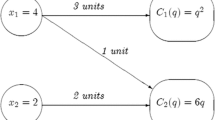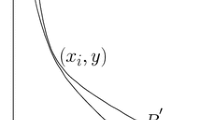Abstract
The purpose of this paper is to investigate the informational requirements of resource allocation processes for convex production economies. First, we establish a lower bound of the message space of an informationally decentralized mechanism that realizes Pareto efficient allocations over the class of classical production economies. Then, it is shown that this lower bound is exactly the size of the message space of the competitive (Walrasian) mechanism, and thus the competitive mechanism is informationally efficient for general neoclassical production economies in the sense that it uses the smallest message space among the class of resource allocation processes that are informationally decentralized and realize Pareto optimal allocations. Further, it is shown that the competitive mechanism is the unique informationally efficient decentralized mechanism that realizes Pareto efficient and individually rational allocations. The results obtained in the paper may shed light on the socialist controversy between Mises-Hayek and Lange-Lerner.
Similar content being viewed by others
Notes
A mechanism is called smooth if the stationary message correspondence is either locally threaded or if the inverse of the stationary message correspondence has a Lipschizian-continuous selection in the subset. Thus, the term “smoothness” used here is not referred as the usual differentiability of a function, but either as local threadedness or the Lipschizian continuity. This terminology was used by Hurwicz (1999). We will give the definition of the local threadedness below.
As usual, vector inequalities, ≧, ≥, and >, are defined as follows: Let \(a,b \in \mathbb{R}^{m} \). Then a ≧ b means a s ≧ b s for all s = 1, ..., m; a ≥ b means a ≧ b but a ≠ b; a > b means a s > b s for all s=1, ..., m.
R i is convex if for bundles a, b, c with 0 < ≦ 1 and c = a + (1−) b, the relation aP i b implies cP i b. Note that the term “convex” is defined as in Debreu (1959), not as in some recent textbooks.
Notice that, the definition of the privacy-preserving mechanism does not exclude the possibility of the presence of externalities since a message reported by one agent may also include, say, the level of production by other producers.
A stronger condition that can guarantee interior outcomes is that a mechanism is individually rational.
References
Calsamiglia X (1977) Decentralized resource allocation and increasing returns. J Econ Theory 14:263–283
Calsamiglia X, Kirman A (1993) A unique informationally efficient and decentralized mechanism with fair outcomes. Econometrica 61:1146–1172
Debreu G (1959) Theory of value. Wiley, New York. 1995
Greenberg M (1967) Lectures on algebraic topology. Benjamin, New York
Hurwicz L (1960) Optimality and informational efficiency in resource allocation processes. In: Arrow KJ, Karlin S, Suppes P (eds) Mathematical methods in the social sciences. Stanford University Press
Hurwicz L (1972) On informationally decentralized systems, in: Radner R, McGuire CB (eds) Decision and organization in honor of J. Marschak. North-Holland, pp 297–336
Hurwicz L (1973) The design of mechanisms for resource allocation. Am Econ Rev 63:1–30
Hurwicz L (1979a) On the dimension requirements of informationally decentralized Pareto-satisfactory processes. In: Arrow K, Hurwicz L (eds) Studies in resource allocation processes. Cambridge University Press
Hurwicz L (1979b) On allocations attainable through Nash equilibria. J Econ Theory 21:149–165
Hurwicz L (1986) On informational decentralization and efficiency in resource allocation mechanism. In: Reiter S (ed) Studies in mathematical economics. Mathematical Association of America
Hurwicz L (1999) Revisiting externalities. J Public Econ Theory 1:225–246
Hurwicz L, Reiter S, Saari D (1985) On constructing mechanisms with message spaces of minimal dimension for smooth performance function. Mimeo, Northwestern University
Ishikida T, Marschak T (1996) Mechanisms that efficiently verify the optimality of a proposed action. Econ Des 2:33–68
Jordan JS (1982) The competitive allocation process is informationally efficient uniquely. J Econ Theory 28:1–18
Jordan JS (1987) The Informational requirements of local stability in decentralized allocation mechanisms. In: Groves T, Radner R, Reiter S (eds) Information, incentives and economic mechanisms. University of Minnesota, Minneapolis
Kelley JL (1955) General topology. Van Nostrand, Princeton, NJ
Lange O (1936–1937) On the economic theory of socialism. Rev Econ Stud 4
Lange O (1942) The foundations of welfare economics. Econometrica 10:215–228
Lerner AP (1944) The economics of control. New York
Marschak T, Reichelstein S (1995) Communication requirements for individual agents in networks and hierarchies. In: Ledyard JO (ed) The economics of informational decentralization: complexity, efficiency, and stability (Essays in Honor of Stanley Reiter). Kluwer, pp 311–346
Maskin E (1999) Nash equilibrium and welfare optimality. Rev Econ Stud 66:23–38
Michael E (1956) Continuous selections I. Ann Math 63:361–382
Mount KR (1995) Mechanisms for the realization of equilibria. In: Ledyard JO (ed) The economics of informational decentralization: complexity, efficiency, and stability (Essays in Honor of Stanley Reiter). Kluwer, pp 35–52
Mount KR, Reiter S (1974) Informational size of message spaces. J Econ Theory 8:161–191
Nayak J (1982) The informational efficiency of the Walras process in economies with production, Research Paper No. 21, Cambridge University
Osana H (1978) On the informational size of message spaces for resource allocation process. J Econ Theory 17:66–78
Reichelstein S, Reiter S (1988) Game forms with minimal strategy spaces. Econometrica 49:661–692
Saari DG (1995) Sufficient statistics, utility theory, and mechanism design. In: Ledyard JO (ed) The economics of informational decentralization: complexity, efficiency, and stability (Essays in Honor of Stanley Reiter). Kluwer Academic Publishers, 219–242
Saijo T (1988) Strategy space reduction in Maskin’s theorem: sufficient conditions for Nash implementation. Econometrica 56:693–700
Sato F (1981) On the informational size of message spaces for resource allocation processes in economies with public goods. J Econ Theory 24:48–69
Tian G (1990) Completely feasible and continuous Nash-implementation of the Lindahl correspondence with a message space of minimal dimension. J Econ Theory 51:443–452
Tian G (1994) On informational efficiency and incentive aspects of generalized ratio equilibria. J Math Econ 23:323–337
Tian G (2000) Incentive mechanism design for production economies with both private and public ownership. Games Econ Behav 33:294–320
Tian G (2004) A unique informationally efficient allocation mechanism in economies with consumption externalities. Int Econ Rev 45:79–111
Varian HR (1992) Microeconomic analysis, 3rd edn. Norton and Company, New York
von Hayek FA (1935) The present state of the debate. In: von Hayek FA (ed) Collectivist economic planning. London
von Hayek FA (1945) The use of knowledge in society. Am Econ Rev 35:519–530
Walker M (1977) On the informational size of message spaces. J Econ Theory 15:366–375
Williams SR (1986) Realization and Nash implementation: two aspects of mechanism design. Econometrica 54:139–151
Acknowledgments
I wish to thank an anonymous referee and the participants at the 2001 Decentralization Conference for valuable comments. This is a reversion of an earlier paper entitled, “The Competitive Mechanism is the Unique Informationally Efficient Process for Economies with Production”. Financial support from the Texas Advanced Research Program as well as from the Bush Fellow Summer Research Program, the Private Enterprise Research Center, and the Lewis Faculty Fellowship at Texas A&M University is gratefully acknowledged.
Author information
Authors and Affiliations
Corresponding author
Additional information
I wish to thank an anonymous referee and the participants at the 2001 Decentralization Conference for valuable comments. This is a reversion of an earlier paper entitled, “The Competitive Mechanism is the Unique Informationally Efficient Process for Economies with Production”. Financial support from the Texas Advanced Research Program as well as from the Bush Fellow Summer Research Program, the Private Enterprise Research Center, and the Lewis Faculty Fellowship at Texas A&M University is gratefully acknowledged.
Rights and permissions
About this article
Cite this article
Tian, G. The unique informational efficiency of the competitive mechanism in economies with production. Soc Choice Welfare 26, 155–182 (2006). https://doi.org/10.1007/s00355-005-0056-0
Received:
Accepted:
Published:
Issue Date:
DOI: https://doi.org/10.1007/s00355-005-0056-0




